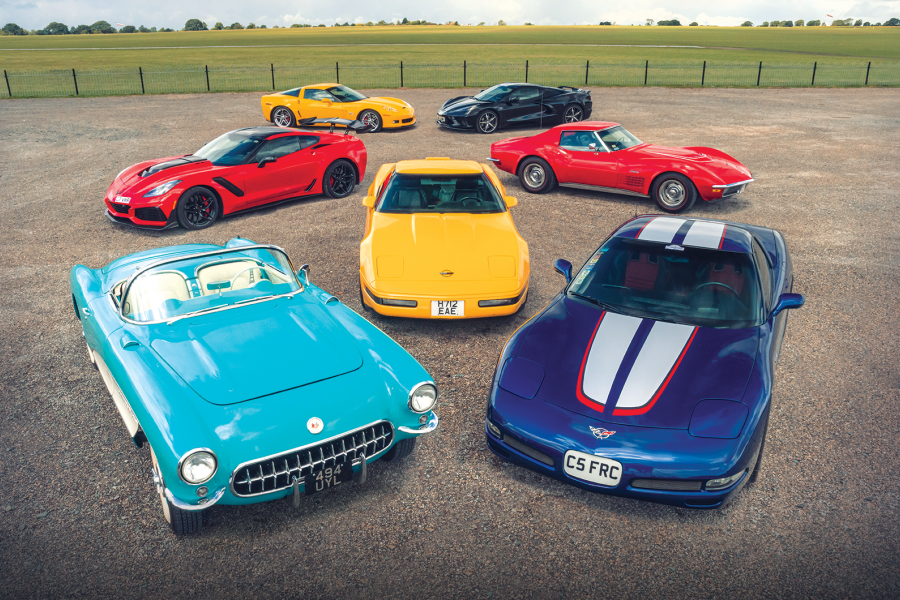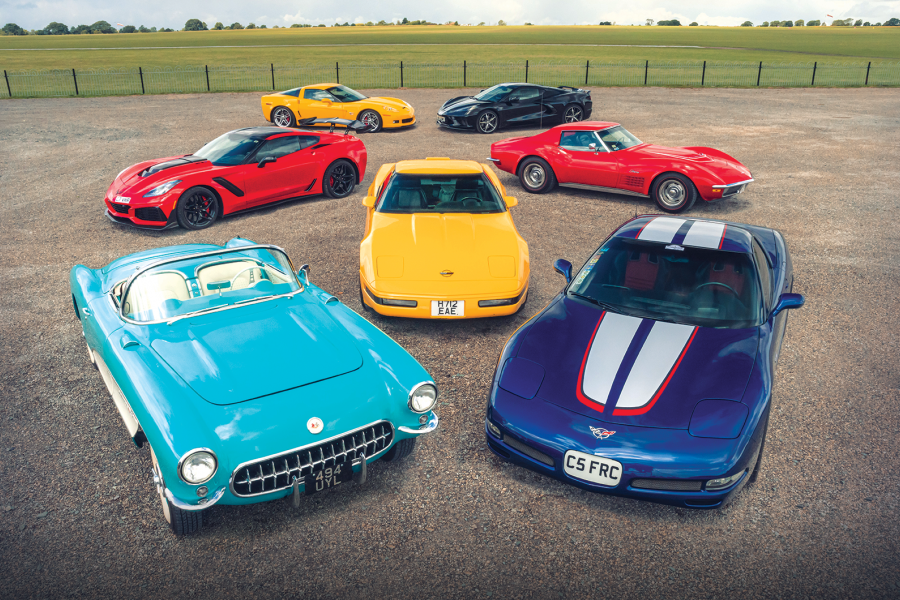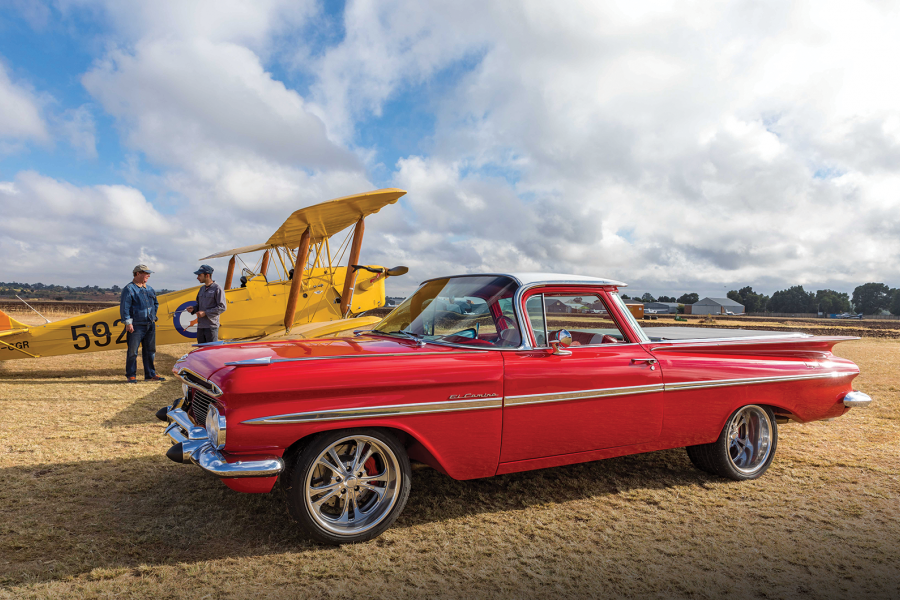This early model sits on the rare Kelsey-Hayes alloy wheels, with knock-off spinners and shod with pre-radial bias-ply tyres.
The Chevrolet Corvette Sting Ray’s red-and-white colour scheme adds to the jukebox glitz of the cabin
It also has an original, dealer-installed radio and the optional N11 ‘Off Road’ exhaust system.
The reason behind the name is unclear: it does give good clearance, but more likely it is derived from the fact that it is completely shrouded from view, aside from the two discreet tailpipes, unlike the more flashy post-’65 side-pipe option.
Next we switch to Michael’s ’65 convertible, which features vents in the front wings that resemble a shark’s gills, for cooling the brakes, and sits on the same rare alloys as Sander’s coupe.
This time there are those $134.50 optional side-pipes, which don’t just look great, but also deliver the creamy roll of V8 thunder in full stereo, as unfettered as possible.
C2 Corvette buyers had the option of a three- or four-speed manual gearbox, or a two-speed automatic
The drop-top’s bright white and lipstick red two-tone interior is a rare option on the C2, but immediately inspires the summer feeling so natural to a Corvette convertible.
Not that it’s an ergonomic masterpiece.
The seat cushions are as flat as Bonneville’s salt and the steering wheel is huge, its thin rim protruding towards you, while the pedals are so big and far apart that heel-and-toeing is not worth attempting.
Yet both have a special feeling on the road, only amplified in the convertible because it gives access to even more of the V8’s sound.
The side pipes add theatre to the already dramatic Corvette Sting Ray
In 1965, Chevrolet introduced the option of a big-block, 369cu in (6.5-litre) V8 with 420bhp to top the range above the four versions of the 327.
In 1967 that was followed by a 427cu in (7-litre) motor with 430bhp, listed with the code L71, and there was also the 500bhp L88 option said to be intended for motorsport – only 20 L88-code Sting Rays were delivered.
Although the big-blocks did have a larger capacity, the name was actually attributed to the size of the bottom end, with the larger cylinders distanced further apart than in the 327.
The Chevrolet Corvette Sting Ray’s 327 engine makes 300bhp
And yet the Sting Ray feels far from short-changed with the 300bhp 327, able to leave almost every contemporary car behind and even taking up the gauntlet with cheeky challengers in modern traffic.
With 360lb ft of torque, there is always enough pulling power under the pedal and in almost any gear.
To accelerate in a 427 is an unforgettable, brutal, spectacular experience, but the 327 is smoother and more harmonious than its rather violent sibling.
It is also 35kg better off, and reverses the weight distribution from 52:48 front to rear to give a surprising rearward bias.
The C2 Corvette’s ‘Turbo-Fire’ badge on the V8 engine is somewhat misleading – there’s no turbocharger
There is an immediate feeling of lazy, long-stroke American V8 thrust when you set off in the C2, its easy performance, stirring soundtrack and the sense of the longevity for which these engines have earned their fame giving it a wonderfully relaxed attitude.
The technology is simple: pushrods, eight spark plugs, 16 valves, a cast-iron block and no fuss.
The V8 can be stirred into giving a donkey-kick response, yet the gentle biting point of the clutch means you can sweep away surprisingly gracefully.
The gearbox, too, makes for easy changes in comparison with the heavier, more mechanically stressed affairs of later ’Vettes.
The C2 Chevrolet Corvette convertible has a plush cabin
Fast cornering can be a challenge, however.
Even a 327 gathers pace more rapidly than you expect, and communication from the chassis isn’t immediate, particularly on radial tyres.
The power-assisted steering is light and feels as if it’s not connected to anything at first, but as soon as you begin to pick up speed it returns some sense of feedback.
It is also fairly quick, with ratios between 19.6:1 and 17:1 that can be adjusted at the steering arms.
‘There is a feeling of lazy, long-stroke thrust, the easy pace and stirring soundtrack giving it a wonderfully relaxed attitude’
Although there is always a certain vagueness to the helm, you soon begin to sense how those tall tyres are bending.
Ultimately, the Corvette needs a bit of space to be stretched with real confidence.
Like in a Cobra, you don’t gain time in the corners with a Sting Ray, but on the stretches of road that connect them.
Once you accept that, it really performs and offers driving pleasure in abundance.
Behind it are the qualities of a legend: a true Stateside original, with massive performance and glorious looks.
Daring, successful and unsurpassed among Corvettes, the C2 might just be America’s greatest sports car.
Images: Luuk van Kaathoven
Factfile
Chevrolet Corvette C2
- Sold/number built 1963-’67/117,964
- Construction steel perimeter-frame chassis, glassfibre body
- Engine all-iron, ohv 5356cc V8, four-barrel Carter AFB carburettor
- Max power 300bhp @ 5000rpm
- Max torque 360lb ft @ 3200rpm
- Transmission three/four-speed manual or two-speed auto, RWD
- Suspension independent, at front by unequal-length wishbones, coil springs, anti-roll bar rear transverse leaf spring, lower links, trailing arms; telescopic dampers f/r
- Steering recirculating ball, optional power assistance
- Brakes drums (discs from 1965)
- Length 14ft 7¼in (4450mm)
- Width 5ft 9½in (1765mm)
- Height 4ft 1¾in (1264mm)
- Wheelbase 8ft 2in (2490mm)
- Weight 3053lb (1385kg, coupe)
- Mpg 14.8
- 0-60mph 7.5 secs
- Top speed 130mph (coupe)
- Price new $4252 (1963, coupe)
- Price now £50-70,000*
*Price correct at date of original publication
Enjoy more of the world’s best classic car content every month when you subscribe to C&SC – get our latest deals here
READ MORE
Transatlantic tussle: Chevrolet Corvette vs Jaguar E-type
Slow burners: Mercedes 190SL vs Corvette C1
70 years of the Chevrolet Corvette





























